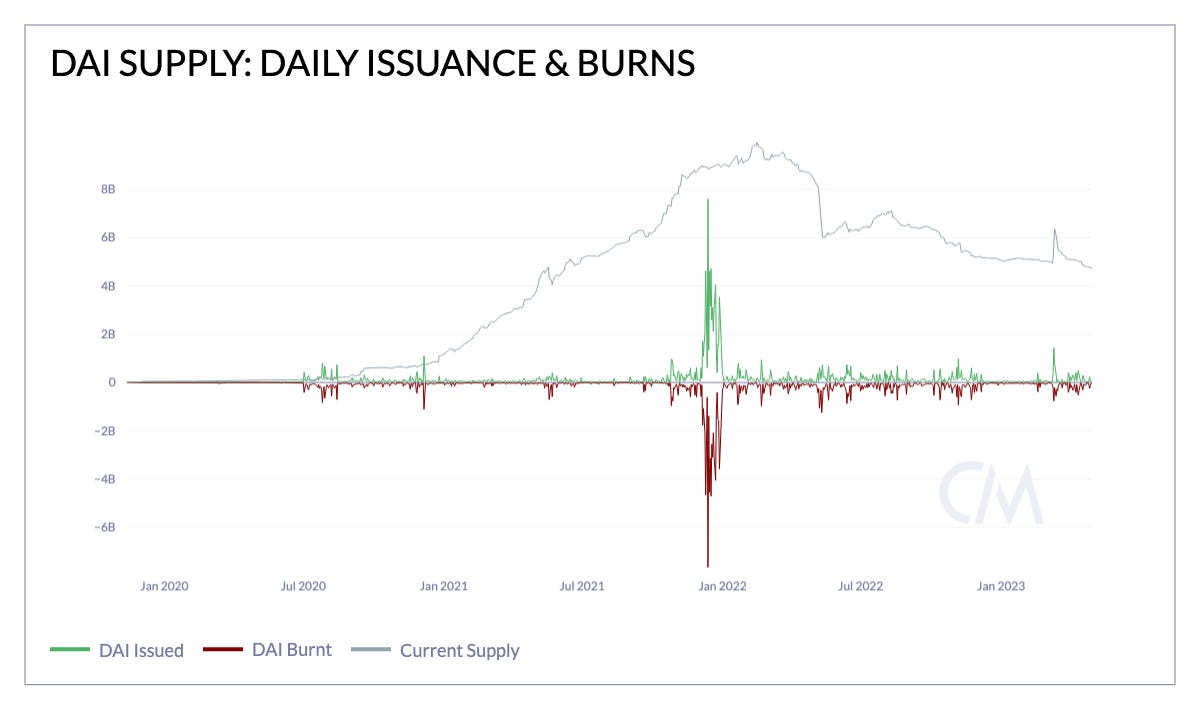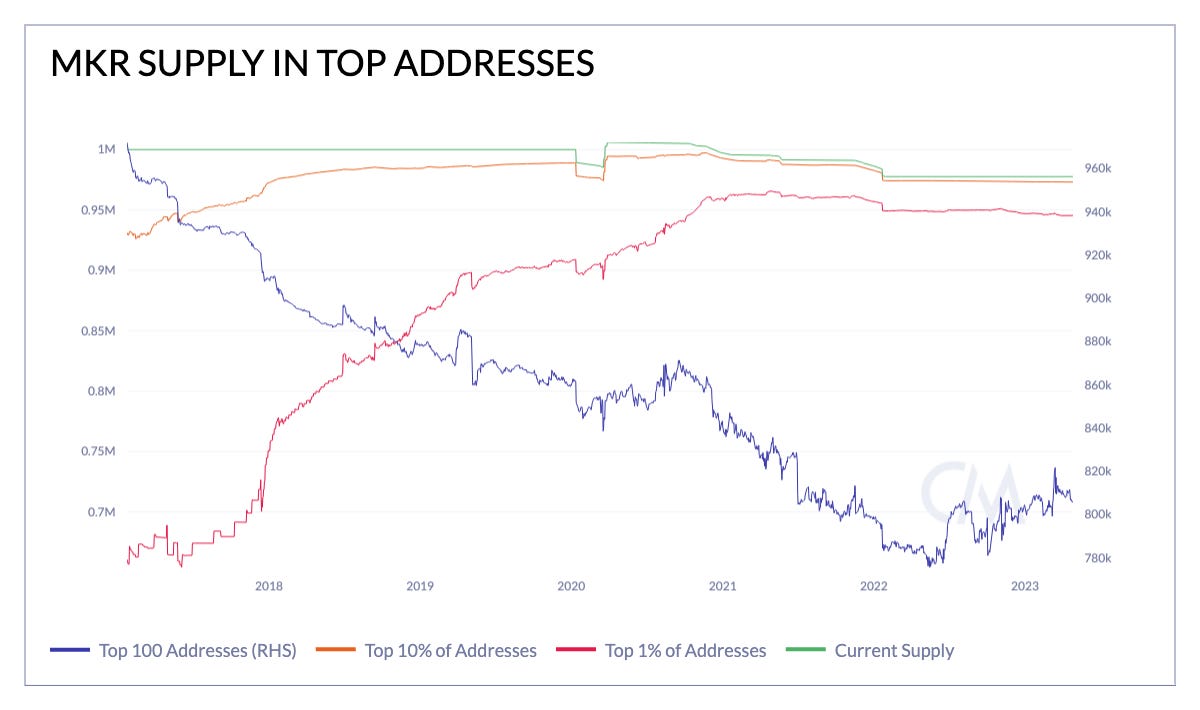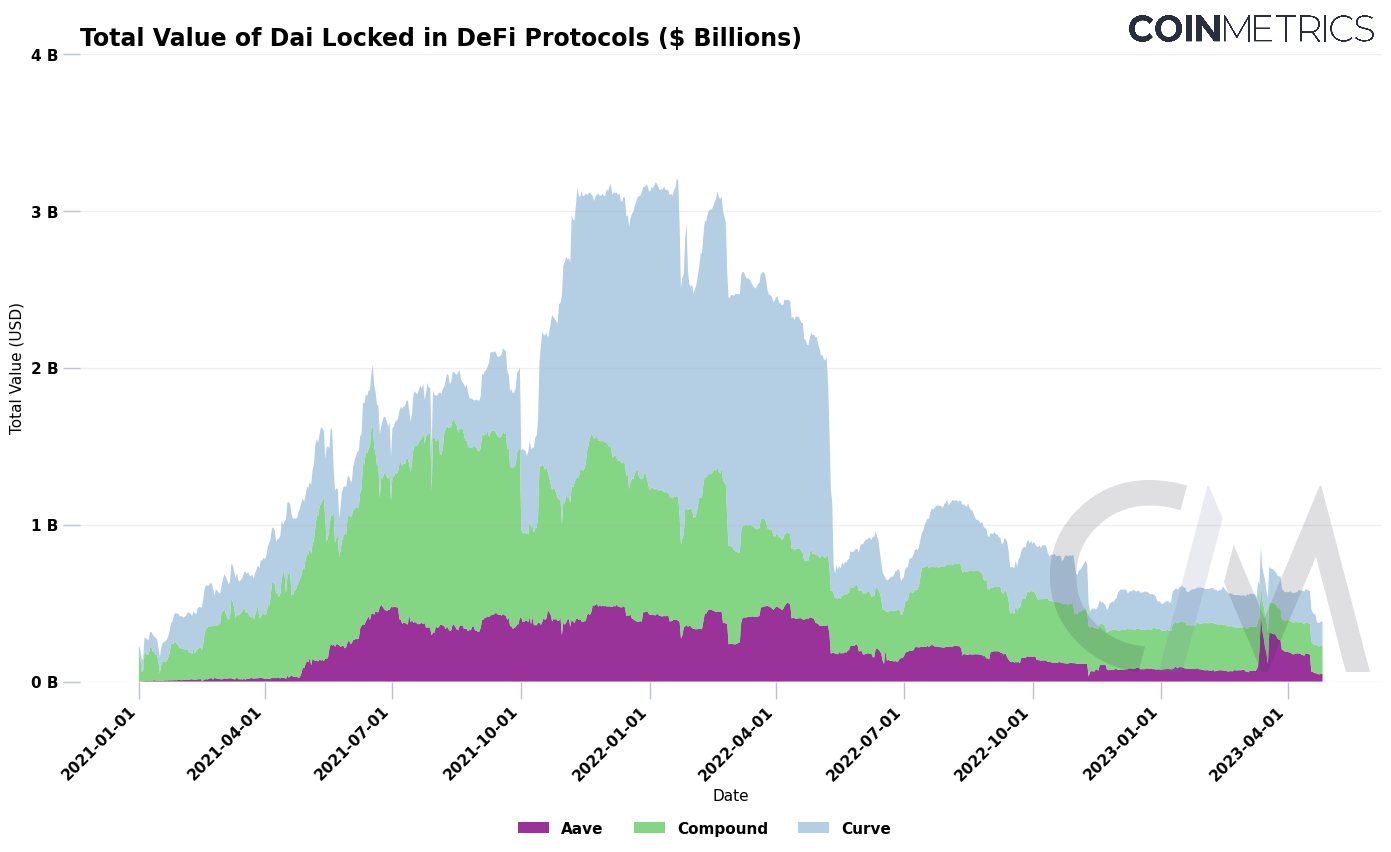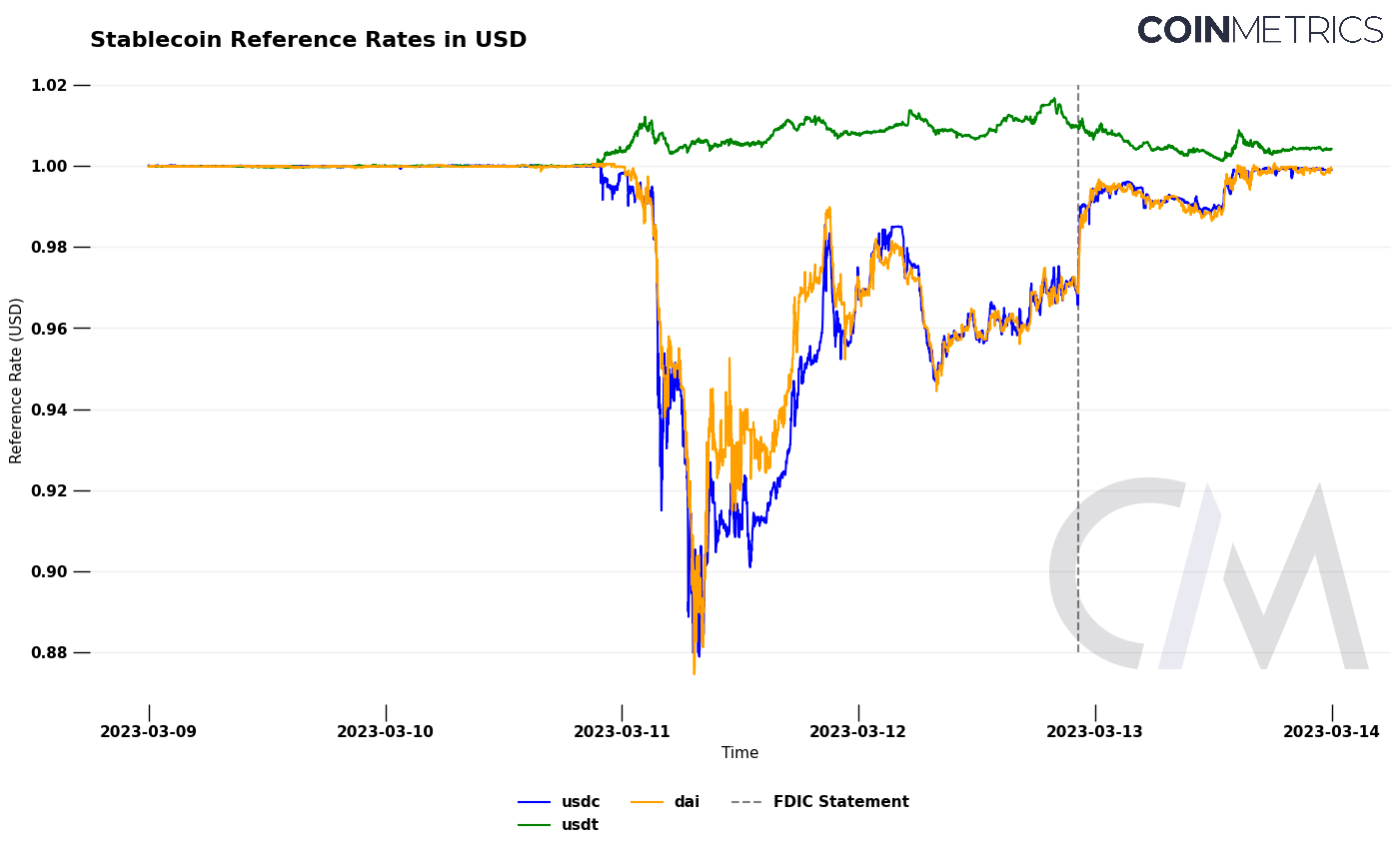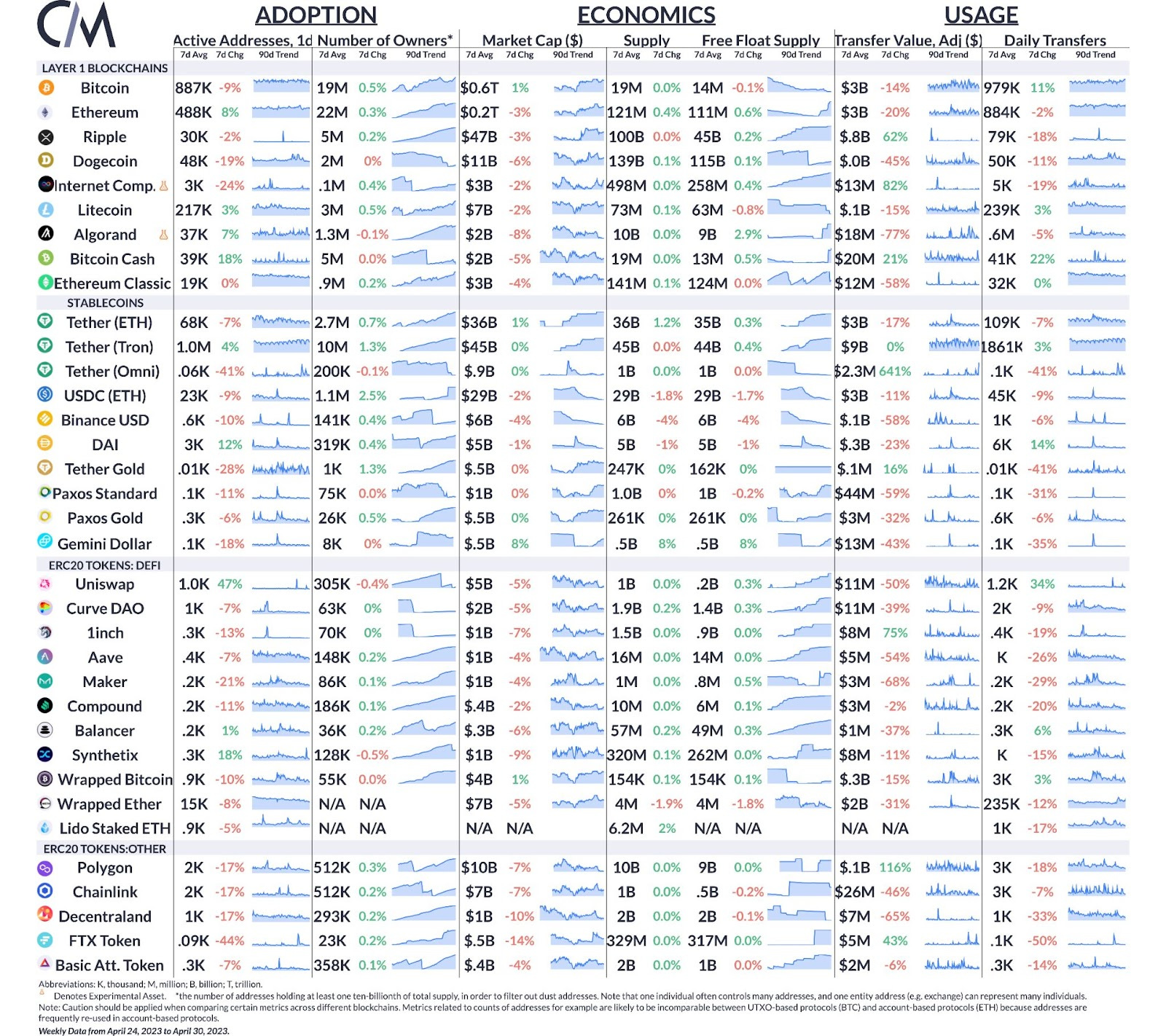Coin Metrics’ State of the Network: Issue 205
Get the best data-driven crypto insights and analysis every week: Maker’s Dai DilemmaBy: Tanay Ved, Matías Andrade, & Kyle Waters Stablecoins have proliferated into a crucial sector of the digital asset economy and are a frequent topic of our discussion. As crypto-assets designed to maintain a stable peg to another asset class such as the US Dollar, stablecoin issuers have adopted varying approaches with the aim of bringing stability to an otherwise volatile asset class. They can be categorized by their underlying collateral structure, ranging from fiat/commodity backed, cryptocurrency backed or algorithmic. Regardless of this, stablecoins are all designed with a single purpose - achieving stability. In this issue of Coin Metrics’ State of the Network we’ll hone in on MakerDAO’s Dai—the largest crypto-backed stablecoin by market capitalization ($4.7 Billion). Through the analysis, we’ll understand how Dai is issued, explore its supply trends and evaluate how the stablecoin is being used today. Most importantly, we’ll also highlight the key risks of crypto-backed stablecoins in the wake of recent de-pegging events and understand a major dilemma MakerDAO is grappling with—achieving stability and decentralization of Dai. MakerDAO & the Issuance of DaiThe Maker protocol was launched in 2017, making it one of the first implementations of a decentralized finance (DeFi) application on the Ethereum blockchain. MakerDAO is a decentralized autonomous organization (DAO) with the primary objective of operating Dai—a stablecoin pegged to the US Dollar. Maker functions similarly to lending platforms, like Aave and Compound, and requires loans to be overcollateralized. Dai is brought into circulation when a user deposits collateral into a Maker Vault, also referred to as a collateralized debt position (CDP). Overcollateralization is a key feature for the health of the Maker protocol which helps ensure that the value of collateral in Maker vaults always exceeds the total Dai in circulation. The protocol also relies on external actors to maintain Dai’s target price and facilitate liquidations in the event of price volatility. Source: Coin Metrics Network Data Pro The current supply of Dai is at $4.7B, falling from its peak at $9.9B in February 2022. To generate Dai, a user can provide any Ethereum-based asset as collateral which has been evaluated and approved by the DAO into a smart contract. Therefore, holders of MakerDAO’s governance token MKR perform a crucial role in the ability to introduce additional forms of collateral or effect changes in various protocol parameters, such as the debt ceiling of approved vaults, adopt or remove assets approved as collateral, etc. MKR holders are incentivized to manage risk effectively as the MKR token is either burned in good times, or issued to cushion bad debt in troubled market times—diluting existing MKR holders. Source: Coin Metrics Network Data Looking at the supply held by top holders can provide insight into how governance decisions can be influenced by large holders. As portrayed in the chart above, supply of MKR held by the top 1% and 10% of addresses has converged over the years with the former increasing from 660k to 945k and the latter growing by only 40k since 2017. On the other hand, supply held by the top 100 addresses bottomed at 775k in May 2022 before rising to 805k. The current supply of MKR is 977k, which indicates that top addresses hold the majority of supply. Dai Supply & Adoption TrendsTo improve our understanding of Dai’s circulating supply, we can break it down into supply held by smart contracts and externally owned accounts (EOA’s). As of today, Dai’s supply in EOAs exceeds supply in smart contracts by $1.57B—a trend that reversed in February, 2022, prior to a market-wide drawdown in May. Currently, more Dai is held by addresses controlled by private keys as opposed to smart-contract code deployed on the network. Source: Coin Metrics Network Data Through the provision of collateral assets, the issuance of Dai allows a user to generate liquidity, utilize it as a means of payment/savings, a medium of exchange or gain utility from its use in DeFi applications. As seen below Dai has been a popular asset for use in lending protocols and in liquidity pools for trading on decentralized exchanges. The total value of Dai locked in Compound reached an all time high of $1.3B going into 2022, but has since reduced to $178M. This can be attributed to declining interest rates for supplying stablecoins across decentralized finance lending markets. Dai also made up a considerable portion of value on Curve, facilitated in part by its largest liquidity pool—3Pool, which experienced a huge reduction in line with the May 2022 crash. Source: Coin Metrics Labs Dai’s Collateral RiskAlthough MakerDAO’s decentralized issuance of Dai reduces custodial risk, it is exposed to several other forms of risk as a result of its collateral backing. The recent instability in the banking system in March 2023 is a prime example of this. In the wake of Silicon Valley Bank’s collapse, several stablecoins experienced volatility due to panic ensuing around $3.3B of Circle’s funds held as deposits in SVB. As holders of USDC began selling/swapping out of USDC, its price de-pegged, reaching a low of ¢0.88. Several USDC holders also deposited their tokens in Maker’s Peg Stability Module (PSM)—a vault comprising three stablecoins that back Dai—Circle’s USDC, Gemini’s GUSD and Paxos’ USDP. Since the PSM enables holders to swap USDC to Dai on a 1:1 basis, the balance of USDC doubled from $2B to over $4B as a result of huge inflows and also caused Dai’s price to lag behind it. The PSM, implemented in December 2020, introduced a new incentive mechanism to stabilize Dai’s price around the $1 peg. The greater stability of Dai’s price proved helpful after Dai’s quick growth in 2021. However, the PSM has also garnered the ire of DAO participants most focused on Dai’s promises as a decentralized stablecoin. Source: Coin Metrics Reference Rates & Atlas V2 Indeed, the events of March renewed several questions around Dai’s collateral pool composition as a large portion is exposed to centralized assets such as USDC, WBTC and forms of Real World Asset (RWA’s) like short term treasuries. But at the same time, the introduction of RWA’s provide new growth opportunities for the protocol and help connect the gap between DeFi and the broader financial markets. MakerDAO’s governance forums have been torn over how to move forward, with some believing in decoupling Dai from the US Dollar to achieve greater decentralization and others believing in retaining USD collateral to prioritize its price stability. While the path forward is unclear, it highlights the importance of governance as a key piece to the puzzle. Despite a slew of challenges and difficult questions, the survival of MakerDAO alone through times of market turbulence and years of change in the crypto ecosystem is a testament to the longevity of the protocol and its ability to adapt. ConclusionWhile the addition of new collateral types introduces potential risks, Maker also faces several challenges in the form of structuring effective governance and tackling regulation. It will also be interesting to follow how new entrants in the stablecoin market such as Aave’s GHO and Curve’s crvUSD (currently on Ethereum testnet) will spur economic activity on each protocol. Having said that, it is not all doom and gloom for Maker as its “Endgame Plan” proposes to overhaul governance and tokenomics of the ecosystem to promote greater stability and resiliency in the future. Network Data InsightsSummary MetricsSource: Coin Metrics Network Data Pro Despite a drop in the number of active addresses, Bitcoin experienced a wave of on-chain activity this past week, leading to a new all-time high in the number of transactions recorded in a single day—561k on April 30th. Meanwhile, Ethereum fees surged, averaging around 40 GWEI, the highest since last spring. This led to nearly 30k ETH being burnt during the week. The supply of USDC fell under 30B on Ethereum for the first time since November 2021. Coin Metrics UpdatesThis week’s updates from the Coin Metrics team:
As always, if you have any feedback or requests please let us know here. Subscribe and Past IssuesCoin Metrics’ State of the Network, is an unbiased, weekly view of the crypto market informed by our own network (on-chain) and market data. If you'd like to get State of the Network in your inbox, please subscribe here. You can see previous issues of State of the Network here. © 2023 Coin Metrics Inc. All rights reserved. Redistribution is not permitted without consent. This newsletter does not constitute investment advice and is for informational purposes only and you should not make an investment decision on the basis of this information. The newsletter is provided “as is” and Coin Metrics will not be liable for any loss or damage resulting from information obtained from the newsletter. |
Older messages
Coin Metrics’ State of the Network: Issue 204
Tuesday, April 25, 2023
Breaking down blockchain addresses
Coin Metrics’ State of the Network: Issue 203
Wednesday, April 19, 2023
Review of Ethereum's 'Shapella' Upgrade
Coin Metrics’ State of the Network: Issue 202
Tuesday, April 11, 2023
A preview of Ethereum's upcoming Shanghai/Capella upgrade
Coin Metrics’ State of the Network: Issue 201
Tuesday, April 4, 2023
A data-driven overview of the events from Q1, 2023
Coin Metrics’ State of the Network: Issue 200
Tuesday, March 28, 2023
Bitcoin Mining Data in Q1 2023
You Might Also Like
Central African Republic’s CAR memecoin raises scrutiny
Friday, February 14, 2025
Allegations of deepfake videos and opaque token distribution cast doubts on CAR's ambitious memecoin project. ͏ ͏ ͏ ͏ ͏ ͏ ͏ ͏ ͏ ͏ ͏ ͏ ͏ ͏ ͏ ͏ ͏ ͏ ͏ ͏ ͏ ͏ ͏ ͏ ͏ ͏ ͏ ͏ ͏ ͏ ͏ ͏ ͏ ͏ ͏ ͏ ͏ ͏ ͏ ͏ ͏ ͏ ͏ ͏
January CEX Data Report: Significant Declines in Trading Volume Across Major CEXs, Spot Down 25%, Derivatives Down…
Friday, February 14, 2025
According to data collected by the WuBlockchain team, spot trading volume on major central exchanges in January 2025 decreased by 25% compared to December 2024. ͏ ͏ ͏ ͏ ͏ ͏ ͏ ͏ ͏ ͏ ͏ ͏ ͏ ͏ ͏ ͏ ͏ ͏ ͏ ͏
Previewing Coinbase Q4 2024 Earnings
Friday, February 14, 2025
Estimating Coinbase's Transaction and Subscriptions & Services Revenue in Q4 2024 ͏ ͏ ͏ ͏ ͏ ͏ ͏ ͏ ͏ ͏ ͏ ͏ ͏ ͏ ͏ ͏ ͏ ͏ ͏ ͏ ͏ ͏ ͏ ͏ ͏ ͏ ͏ ͏ ͏ ͏ ͏ ͏ ͏ ͏ ͏ ͏ ͏ ͏ ͏ ͏ ͏ ͏ ͏ ͏ ͏ ͏ ͏ ͏ ͏ ͏ ͏ ͏ ͏ ͏ ͏ ͏
ADA outperforms Bitcoin as Grayscale seeks approval for first US Cardano ETF in SEC filing
Friday, February 14, 2025
Grayscale's Cardano ETF filing could reshape ADA's market position amid regulatory uncertainty ͏ ͏ ͏ ͏ ͏ ͏ ͏ ͏ ͏ ͏ ͏ ͏ ͏ ͏ ͏ ͏ ͏ ͏ ͏ ͏ ͏ ͏ ͏ ͏ ͏ ͏ ͏ ͏ ͏ ͏ ͏ ͏ ͏ ͏ ͏ ͏ ͏ ͏ ͏ ͏ ͏ ͏ ͏ ͏ ͏ ͏ ͏ ͏ ͏
AI project trading tips: investment targets and position management
Friday, February 14, 2025
This interview delves into the investment trends, market landscape, and future opportunities within AI Agent projects. ͏ ͏ ͏ ͏ ͏ ͏ ͏ ͏ ͏ ͏ ͏ ͏ ͏ ͏ ͏ ͏ ͏ ͏ ͏ ͏ ͏ ͏ ͏ ͏ ͏ ͏ ͏ ͏ ͏ ͏ ͏ ͏ ͏ ͏ ͏ ͏ ͏ ͏ ͏ ͏ ͏
DeFi & L1L2 Weekly — 📈 Polymarket recorded a new high of 462.6k active users in Jan despite volume dip; Holesky a…
Friday, February 14, 2025
Polymarket recorded a new high of 462600 active users in January despite volume dip; Holesky and Sepolia testnets are scheduled to fork in Feb and Mar for Ethereum's Pectra upgrade. ͏ ͏ ͏ ͏ ͏ ͏ ͏ ͏
DeFi & L1L2 Weekly — 📈 Polymarket recorded a new high of 462.6k active users in Jan despite volume dip; Holesky a…
Friday, February 14, 2025
Polymarket recorded a new high of 462600 active users in January despite volume dip; Holesky and Sepolia testnets are scheduled to fork in Feb and Mar for Ethereum's Pectra upgrade. ͏ ͏ ͏ ͏ ͏ ͏ ͏ ͏
Donald Trump taps crypto advocate a16z’s Brian Quintenz for CFTC leadership
Friday, February 14, 2025
Industry leaders back Brian Quintenz's nomination, highlighting his past efforts at the CFTC and potential to revamp crypto oversight. ͏ ͏ ͏ ͏ ͏ ͏ ͏ ͏ ͏ ͏ ͏ ͏ ͏ ͏ ͏ ͏ ͏ ͏ ͏ ͏ ͏ ͏ ͏ ͏ ͏ ͏ ͏ ͏ ͏ ͏ ͏
⚡10 Tips to Make a Living Selling Info Products
Friday, February 14, 2025
PLUS: the best links, events, and jokes of the week → ͏ ͏ ͏ ͏ ͏ ͏ ͏ ͏ ͏ ͏ ͏ ͏ ͏ ͏ ͏ ͏ ͏ ͏ ͏ ͏ ͏ ͏ ͏ ͏ ͏ ͏ ͏ ͏ ͏ ͏ ͏ ͏ ͏ ͏ ͏ ͏ ͏ ͏ ͏ ͏ ͏ ͏ ͏ ͏ ͏ ͏ ͏ ͏ ͏ ͏ ͏ ͏ ͏ ͏ ͏ ͏ ͏ ͏ ͏ ͏ ͏ ͏ ͏ ͏ ͏ ͏ ͏ ͏ ͏ ͏ ͏ ͏ ͏ ͏
Interview with CryptoD: How He Made $17 Million Profit on TRUMP Coin
Friday, February 14, 2025
Author | WUblockchain, Foresight News ͏ ͏ ͏ ͏ ͏ ͏ ͏ ͏ ͏ ͏ ͏ ͏ ͏ ͏ ͏ ͏ ͏ ͏ ͏ ͏ ͏ ͏ ͏ ͏ ͏ ͏ ͏ ͏ ͏ ͏ ͏ ͏ ͏ ͏ ͏ ͏ ͏ ͏ ͏ ͏ ͏ ͏ ͏ ͏ ͏ ͏ ͏ ͏ ͏ ͏ ͏ ͏ ͏ ͏ ͏ ͏ ͏ ͏ ͏ ͏ ͏ ͏ ͏ ͏ ͏ ͏ ͏ ͏ ͏ ͏ ͏ ͏ ͏ ͏ ͏ ͏ ͏ ͏ ͏ ͏ ͏ ͏


